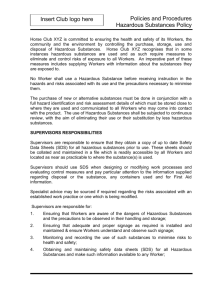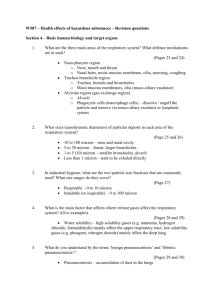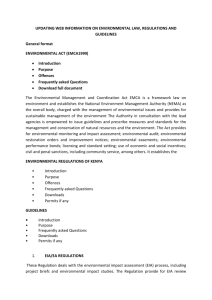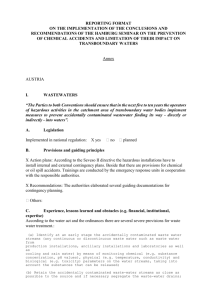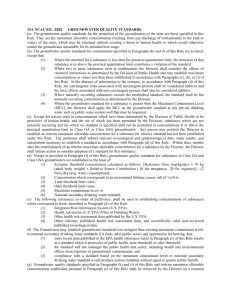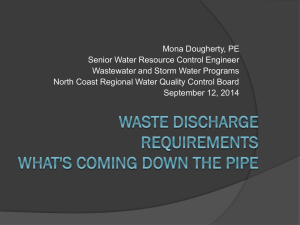Dr Karen - Department of Environment and Local Government
advertisement
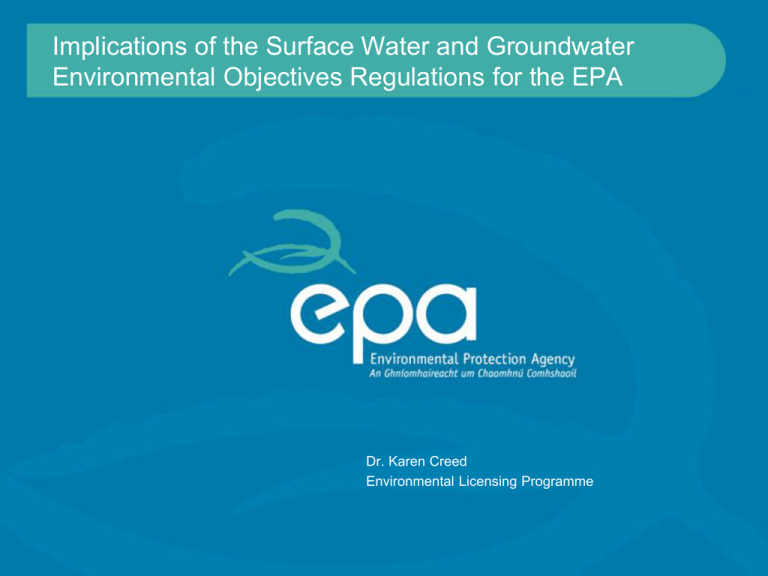
Implications of the Surface Water and Groundwater Environmental Objectives Regulations for the EPA Dr. Karen Creed Environmental Licensing Programme Overview Articles and schedules that apply to the licensing Implications for licensing How the Agency applies the requirements of the articles and schedules to licences Other implications Implications of the Surface Water Regulations for Licensing Articles 4, 5, 6 Article 7 Article 9 Article 11 Schedules 5 and 6 Articles 4, 5 and 6 Ensure surface waters comply with EQS Protected areas comply with relevant standards The most stringent standards apply Within specified timeframes Consult, co-operate and liaise with other public authorities No deterioration in chemical or ecological status Applicable measures Reducing pollution by priority substances and ceasing or phasing out emissions, discharges and losses of priority hazardous substances Licence Condition A representative sample of effluent from the primary discharge point shall be screened for the presence of organic compounds and metals as required by the Agency. The list of parameters for analysis shall include, as a minimum, those organic compounds and metals identified as relevant having regard to the Water Policy Regulations 2003 and amendments (S.I. No. 722 of 2003 and amendments) and any other relevant legislation. Such screening shall be repeated at intervals as requested by the Agency. The licensee shall, within twelve months of the date of grant of this licence, investigate the sources of any elevated dangerous substances detected during sampling for the purposes of the licence application, and take such measures as are necessary to minimise the discharge of such substances from the waste water works. A report on the investigation and measures identified, including timeframe for implementation, shall be included in the AER. Article 7 Emission Limits Combined Approach Emission controls based on best available techniques, or Relevant emission limit values, or In the case of diffuse impacts controls, best environmental practices or measures and controls identified in PRPs. Article 9 Article 7 shall apply to all new and review authorisations IPPC Waste Waste Water Discharges Dumping at Sea Article 11 Examine all authorisations IPPC, Waste, Waste Water, Dumping at Sea in accordance with Article 11 by 22nd December 2012. REVIEW No No further action Yes Completed by 22nd December 2012 Schedule 5 How do we ensure the EQS are met? Assimilative capacity and mass balance Set ELVs and conditions Monitoring Programme of Improvements Reporting Financial Provisions Schedule 5 What do we do when conditions upstream are already failing to meet good status? Assess impact of the discharge separately from impacts upstream Theoretical background concentrations MRP (mg P/l) 0.005 Ammonia (mg N/l) 0.008 BOD (mg/l O2) 0.260 DIN – Dissolved Inorganic Nitrogen DIN is the sum of the concentrations of nitrate (NO3), nitrite (NO2) and ammonia (NH3). Coastal Waters DIN EQO ELV for total oxidised nitrogen (TON) and ammonia A requirement to monitor the discharge(s) for TON and ammonia A requirement to monitor the ambient aquatic environment for DIN Other implications Inventory of emissions, discharges and losses of priority and priority hazardous substances. Monitoring of sediments and biota Consultation on PRP Enforcement Classify waters Calculation of ecological status, ecological potential and chemical status Surface Water Regulations Article 70: Local Government (Water Pollution Act 1977 (Water Quality Standards for Phosphorous Regulations 1998 (S.I. No. 258 of 1998) Water Quality (Dangerous Substances) Regulations 2001 (S.I. No 12 of 2001) ARE REVOKED Implications of the Groundwater Regulations for Licensing Article 4, 5 ,6 Articles 8 & 9 Articles 12 & 13 Schedules Articles 4, 5 and 6 Prevent or limit input of pollutants Prevent deterioration of status Protected areas comply with relevant standards Reverse upward trend in concentration of any pollutant resulting from the impact of human activity Consult, co-operate and liaise with other public authorities Articles 8 & 9 Direct discharge of pollutants to groundwater is prohibited Certain discharges may be permitted Input of hazardous substances into groundwater is prohibited Input of non-hazardous substances shall be limited Reviews Examine all authorisations in accordance with Article 12 by 22nd December 2012. REVIEW No No further action Yes Completed by 22nd December 2012 Other implications Identify and publish a list of substances considered to be hazardous and non hazardous by 22nd June 2010 Issue advice and give direction Assess existing codes of practice, identify other areas/activities requiring control and direct public authorities to undertake the work Exemptions Prosecutions Classify groundwater bodies Other implications Review of threshold values Consultation with Northern Ireland Authorities Identification of trends and starting point of trend reversal Measures to reverse upward trends Trend assessment for existing pollution plumes, in particular, those plumes resulting from point sources and contaminated land Technical report as a background document supporting RBMPs Thank You

